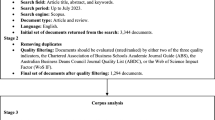Abstract
This paper describes an action research study where the business requirements analysis approach of a business intelligence development project was enriched. Critical systems heuristics, a critical systems methodology that is positioned in the critical systems thinking paradigm, was applied to surface the inherently conflicting views and visions (however unknown to them) that the various stakeholders had regarding a new business intelligence system and its underlying business process. It therefore enabled surfacing of human/cultural and organisational issues that would have negatively affected the adoption of the new system; these were successfully resolved. Accordingly, the various stakeholders reflected on their real requirements that constituted improvement, rather than mere automation, of a business process; it ultimately resulted in a successful new business intelligence system that realised business benefits.
Similar content being viewed by others
References
Avison D, Fitzgerald G (2006) Information systems development: methodologies, techniques and tools. McGraw-Hill, London
Baskerville RL (1999) Investigating information systems with action research. Commun Assoc Inf Syst 2:1–32
Baskerville RL, Wood-Harper AT (1996) A critical perspective on action research as a method for information systems research. J Inf Technol 11:235–246. doi:10.1080/026839696345289
Bentley Y, Cao G, Lehaney B (2013) The application of critical systems thinking to enhance the effectiveness of a university information system. Syst Pract Action Res 26:451–465. doi:10.1007/s11213-012-9253-9
Checkland P (1981) Systems thinking, systems practice. Wiley, Chichester
Checkland P, Holwell S (1998) Information, systems, and information systems: making sense of the field. Wiley, Chichester
Clegg B, Shaw D (2008) Using process-oriented holonic (PrOH) modelling to increase understanding of information systems. Inf Syst J 18:447–477. doi:10.1111/j.1365-2575.2008.00308.x
Dresner Advisory Services L (2012) Wisdom of the crowd™. Business intelligence market study(R). www.yellowfinbi.com/Document.i4?DocumentId=159663. Accessed 15 May 2014
Flood RL, Jackson MC (1991) Creative problem solving: total systems intervention. Wiley, Chichester
Gardner SR (1998) Building the data warehouse. Commun ACM 41:52–60
Gartner (2011) Business intelligence adoption trends. http://my.gartner.com/portal/server.pt?open=512&objID=256&mode=2&PageID=2350940&ref=WorkGroupWidgetContent&resId=1852916. Accessed 15 May 2013
Gartner (2013) Gartner says business intelligence/analytics is top area for CFO technology investment through 2014. http://www.gartner.com/newsroom/id/2488616. Accessed 6 Nov 2013
Goede R (2005) A framework for the explicit use of specific systems thinking methodologies in data-driven decision support system development. University of Pretoria, Diss
Goede R (2012) Critical systems thinking: from foundation to practice in information systems development. Paper presented at the 18th annual working conference of the IIDE
Hirschheim R, Klein HK (1994) Realizing emancipatory principles in information systems development: the case for ETHICS. MIS Q 18:83–105
Hwang MI, Hongjiang X (2007) The effect of implementation factors on data warehousing success: an exploratory study. J Inf Inf Technol Organ 2:1–14
Inmon B (2005) World-class business intelligence DM review. Inf Manag 15:60–61
Jackson MC (2001) Critical systems thinking and practice. Eur J Op Res 128:233–244. doi:10.1016/S0377-2217(00)00067-9
Keating CB, Padilla JJ, Adams K (2008) System of systems engineering requirements: challenges and guidelines. Eng Manag J 20:24–31
Kimball R, Ross M (2010) The kimball group reader: relentlessly practical tools for data warehousing and business intelligence. Wiley, Indianapolis
Leffingwell D (1997) Understanding user needs. Softw Dev 5:51–55
Lewin K (1946) Action research and minority problems. J Soc Issues 2:34–46
Maté A, Trujillo J, Franch X (2014) Adding semantic modules to improve goal-oriented analysis of data warehouses using I-star. J Syst Softw 88:102–111. doi:10.1016/j.jss.2013.10.011
Mingers J, White L (2010) A review of the recent contribution of systems thinking to operational research and management science. Eur J Op Res 207:1147–1161. doi:10.1016/j.ejor.2009.12.019
Naur P, Randell B (eds) (1969) Software engineering: report on a conference, Garmisch, Germany. Scientific Affairs Division, NATO, Brussels
Newman WM, Lamming MG (1995) Interactive system design. Addison-Wesley, Essex
Petkova O, Petkov D (2002) On an application of critical systems heuristics in a framework for evaluation of software development productivity. In: Ragsdell G, West D, Wilby J (eds) Systems theory and practice in the knowledge age. Springer, New York, pp 239–246. doi:10.1007/978-1-4615-0601-0_28
PMI (2013) A guide to the project management body of knowledge (PMBOK guide). Project Management Institute, Newtown Square
Popovič A, Jaklič J, Hackney R, Coelho PS (2012) Towards business intelligence systems success: effects of maturity and culture on analytical decision making. Decis Support Syst 54:729–739. doi:10.1016/j.dss.2012.08.017
Sawyer P, Sommerville I, Viller S (1997) Requirements process improvement through the phased introduction of good practice software process. Improv Pract 3:19–34
Sommerville I (2011) Software engineering, 9th edn. Addison-Wesley, New York
Ulrich W (1983) Critical heuristics of social planning. Haupt, Bern
Ulrich W (2001) A philosophical staircase for information systems definition. Des Dev J Inf Technol Theory Appl 3:55–84
Ulrich W (2003) Beyond methodology choice: critical systems thinking as critically systemic discourse. J Op Res Soc 54:325–342. doi:10.1057/palgrave.jors.2601518
Ulrich W (2005) A brief introduction to critical systems heuristics (CSH). http://wulrich.com/downloads/ulrich_2005f.pdf. Accessed 24 Feb 2014
Ulrich W (2013) Critical systems thinking. In: Gass SI, Fu MC (eds) Encyclopedia of operations research and management science. Springer, New York, pp 314–326
Warren L, Adman P (1999) The use of critical systems thinking in designing a system for a university information systems support service. Inf Syst J 9:223–242. doi:10.1046/j.1365-2575.1999.00058.x
Author information
Authors and Affiliations
Corresponding author
Rights and permissions
About this article
Cite this article
Venter, C., Goede, R. The Use of Critical Systems Heuristics to Surface and Reconcile Users' Conflicting Visions for a Business Intelligence System. Syst Pract Action Res 30, 407–432 (2017). https://doi.org/10.1007/s11213-016-9401-8
Published:
Issue Date:
DOI: https://doi.org/10.1007/s11213-016-9401-8




